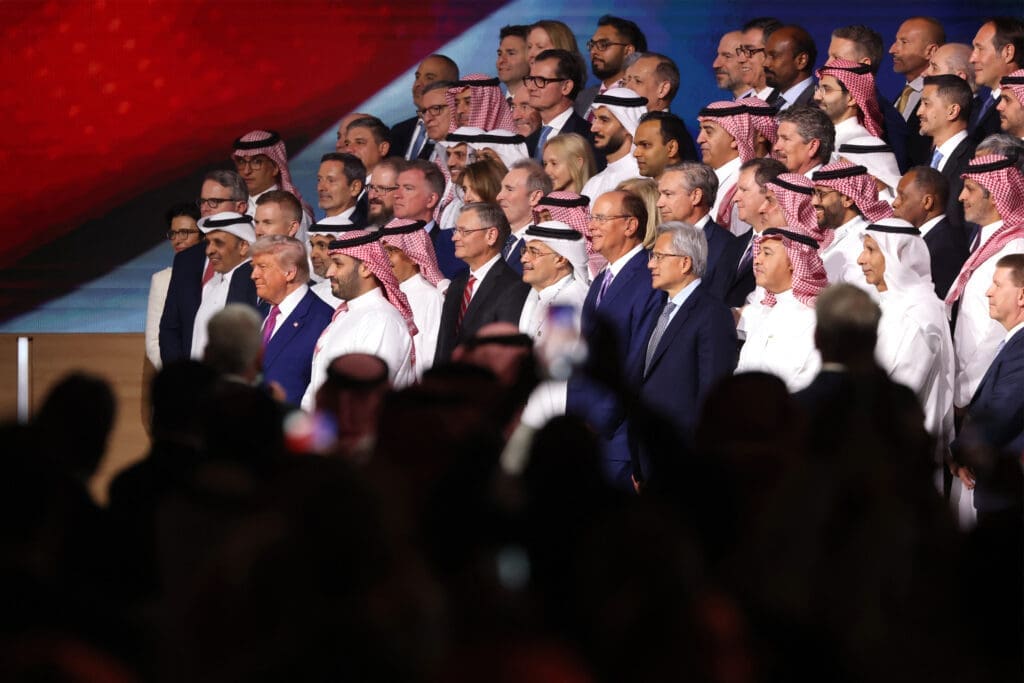Donald Trump’s return to the Gulf in May, the first overseas trip of his second term as U.S. president, was no normal diplomatic visit. It was a strategic encounter shaped by mutual interests and shifting global dynamics. For Gulf leaders, the visit offered an opportunity to reposition themselves not just as regional actors in the U.S.-led order, but as shareholders in an emerging global system, one shaped by transactional diplomacy, technological integration and access to capital, influence and strategic decision-making.
The Gulf states had prepared for the visit with clear intentions: to anchor their national development agendas within the logic of global competition, to leverage their capital and connectivity, and to ensure that the United States, under Trump, remains engaged—but on terms defined in Abu Dhabi, Riyadh and Doha, not just in Washington. This was not a return to old alignments, but a recalibration.
Trump, in turn, came not with a doctrine, but with a deal-making posture that aligns neatly with the Gulf states’ approach to international politics. The visit therefore unveiled a new phase of U.S.-Gulf relations.
What the Gulf States Wanted
The Gulf capitals hosting Trump had a clear agenda. First, they sought to clarify what kind of administration they were dealing with. Would Trump stick to his instincts from his first term: transactional, anti-institutional and tolerant of regional assertiveness? Or had the political cost of his past policies reshaped his approach to the Gulf?
Second, they aimed to secure favorable economic and technological positions for their countries’ futures. The region no longer sees technology merely as a development tool, but as a geopolitical asset. Saudi Arabia launched Humain, an artificial intelligence (AI) firm built to localize technology and develop Arabic-language AI models, positioning the kingdom at the intersection of digital infrastructure and regional identity. Qatar, focused more on soft power and education, emphasized its diplomatic role and deepened its tech partnerships through deals on cooperation with American universities and upgrades of military bases. The United Arab Emirates sought to deepen its tech integration with the U.S., particularly on AI and semiconductors. Emirati entities committed to massive chip purchases, signed deals with tech giants Microsoft, Oracle and Nvidia, and emphasized their ambition to become the Silicon Valley of the Arab world.
Third, they sought to advance their regional diplomatic agendas. Gulf leaders needed the visit to underscore their central role in shaping the region’s evolving security and political architecture. Saudi Arabia aimed to solidify its leadership role in reintegrating Syria and to steer regional politics toward stability and de-escalation. Qatar sought to affirm its position as a trusted mediator, not just on Gaza, but also on Iran-related talks and Afghanistan, and to maintain its role as a necessary, independent channel for regional diplomacy.
Finally, the Gulf sought to reaffirm its relevance in a world where American attention is no longer guaranteed, while also signaling that they cannot be taken for granted. With China and India expanding their commercial and technological footprints, Gulf leaders wanted to send the message that their alignment with Washington is no longer automatic: it must be negotiated, sustained and mutually beneficial.
What They Got
What Gulf states received from Trump’s visit was clarity, not commitments.
Trump used a tone now familiar in his dealings with the Gulf: business-driven, non-confrontational and eager to re-engage. But beyond the optics, there were no formal security agreements, no reversal of congressional barriers to arms deals, and no breakthrough diplomatic initiatives. What the visit revealed was the U.S. president’s continued preference for capital, access to high-value technology sectors, and narrative framing, not institutional realignment.
Saudi Arabia’s objectives centered on visibility and long-term positioning. The headline of $142 billion in defense deals grabbed attention, but insiders estimate that the actual value is far lower, as many of the announced deals are not binding, include previously negotiated agreements, and remain subject to congressional scrutiny. More significant was the quiet reactivation of civil nuclear discussions and the continued framing of Riyadh as a regional economic and military anchor. In contrast to Trump’s 2017 visit, this time the kingdom’s approach was more measured: less performance, more structure. Riyadh used the visit to reinforce its centrality in shaping regional diplomacy, security coordination and economic transformation, without overselling the moment.
Qatar’s engagement was more strategic than theatrical. With a $1.2 trillion economic exchange framework and a $10 billion investment to upgrade Al Udeid Air Base, Doha maintained its posture as both a reliable security partner and an active diplomatic broker. Its emphasis on mediation, particularly on Gaza and the Iran nuclear file, was reflected in Trump’s remarks, which acknowledged Qatar’s growing relevance without attempting to steer it. Qatar’s strength lies in how it moves between global and regional theaters without becoming beholden to any particular one.
The UAE, for its part, focused on deepening its role as a tech and capital hub. Its investments into the U.S. were matched by the high-level tech partnerships mentioned above and by ongoing efforts to purchase advanced semiconductor equipment. Abu Dhabi used the visit to reaffirm its position within the U.S. innovation and AI ecosystem, while carefully balancing its exposure to Chinese-linked firms.
On normalization with Israel, the visit produced no new announcements, but left the door open. Trump reiterated his support for the Abraham Accords, but amid the continuing war in Gaza and a shifting Arab political climate, Gulf leaders were more interested in preserving room for maneuver than in announcing symbolic progress. Normalization remains on the table, but only on their terms.
Another key outcome of the visit was the lifting of U.S. sanctions on Syria, a move that reflected growing Gulf influence in shaping U.S. strategy across the region. For Gulf states, and particularly for Saudi Arabia, this shift was not a favor; it was a strategic priority. Riyadh has positioned itself as central to the re-integration of Syria into Arab diplomacy, and the fact that the sanctions relief was announced in Riyadh validated Saudi lobbying for a managed transition to end Syria’s isolation. It also underlined Saudi Arabia’s leadership role. For the Gulf, stabilizing Syria is not just about reconstruction or the return of refugees; it is about reducing Iranian influence, reasserting Arab political agency and demonstrating that Gulf states can produce diplomatic outcomes. Riyadh’s success was therefore a clear example of shaping U.S. policy, not following it.
Strategic Patience and Hedging
The most important outcome of the visit may have been what did not happen: the Gulf did not overcommit. There was no return to the old model of dependency on the U.S. Instead, Trump’s trip confirmed that Gulf states are pursuing strategic patience—managing uncertainty without surrendering leverage.
All three major Gulf players—Saudi Arabia, the UAE and Qatar—are now practicing calibrated hedging. The UAE continues to cooperate with China on commercial technology while realigning sensitive sectors like AI and defense toward the U.S. to preserve its strategic access to those sectors. Saudi Arabia is engaging in quiet diplomacy with Iran, not as a favor to the U.S., but because its Vision 2030 development strategy depends on domestic and regional stability and avoiding escalation. Qatar is balancing its American military partnership with relationships that span the region’s fault lines, from Gaza to Kabul to Tehran.
The Gulf states’ unspoken logic is simple: diversify alliances, but preserve autonomy. Washington remains a key partner, but not the only one. Gulf states have learned to deal with different types of American presidents: cautious ones, ideological ones and unpredictable ones. That is the key shift: the Gulf no longer reacts to U.S. politics; it prices it in.
Trump’s visit to the Gulf did not redefine the region’s future. It confirmed that the region is already defining it for itself. What the Gulf wanted was not inclusion in an American-led order. It wanted confirmation that it could continue building its own—defined by capital, connectivity and calculated engagement. The visit was not a return to the past, but a test of a new phase: one in which Washington remains an indispensable, but not exclusive, partner.
Trump’s visit offered a reminder that the Gulf is not waiting to be led. It is positioning itself to lead, making sure that those who want to work with it know exactly what is on the table—and what is not.


